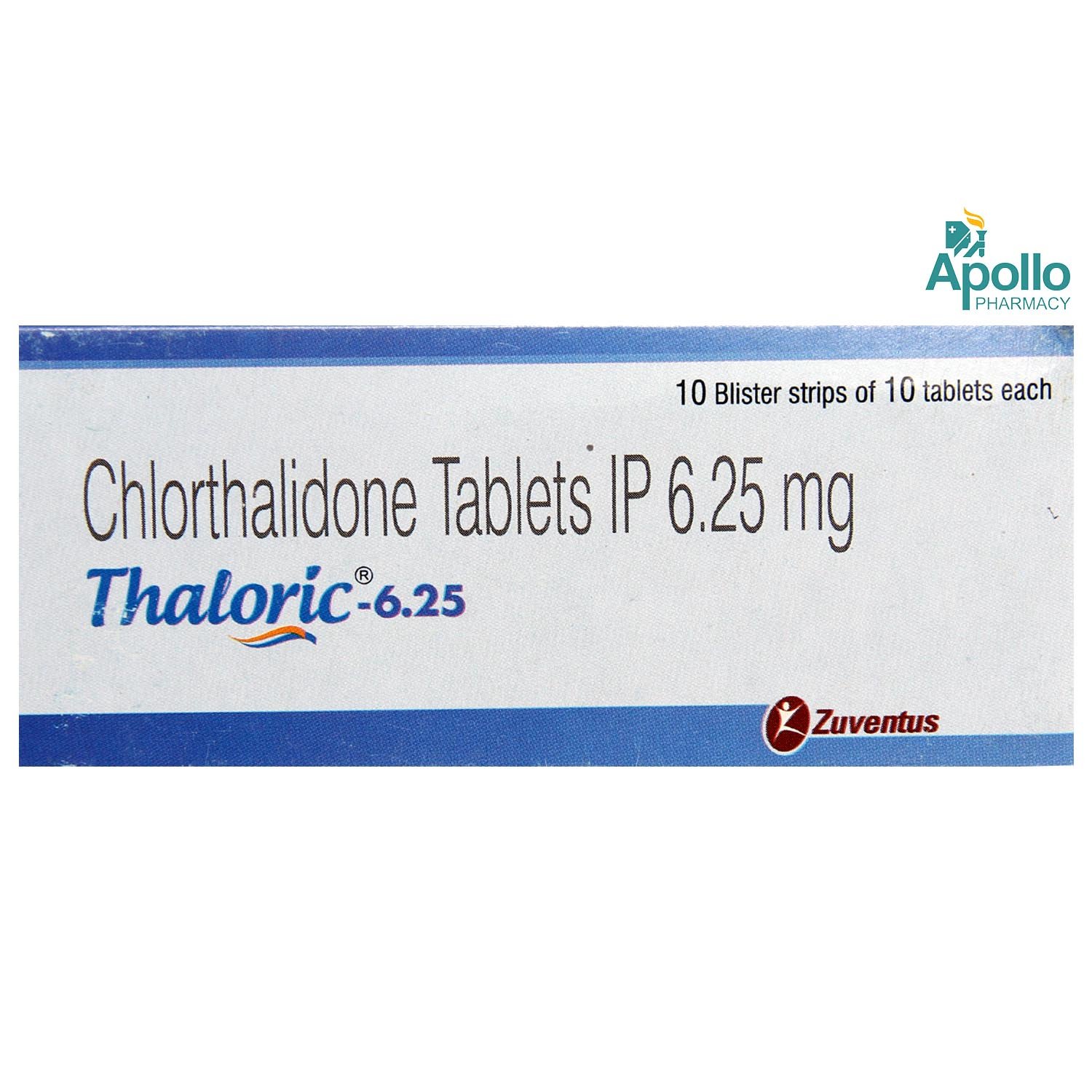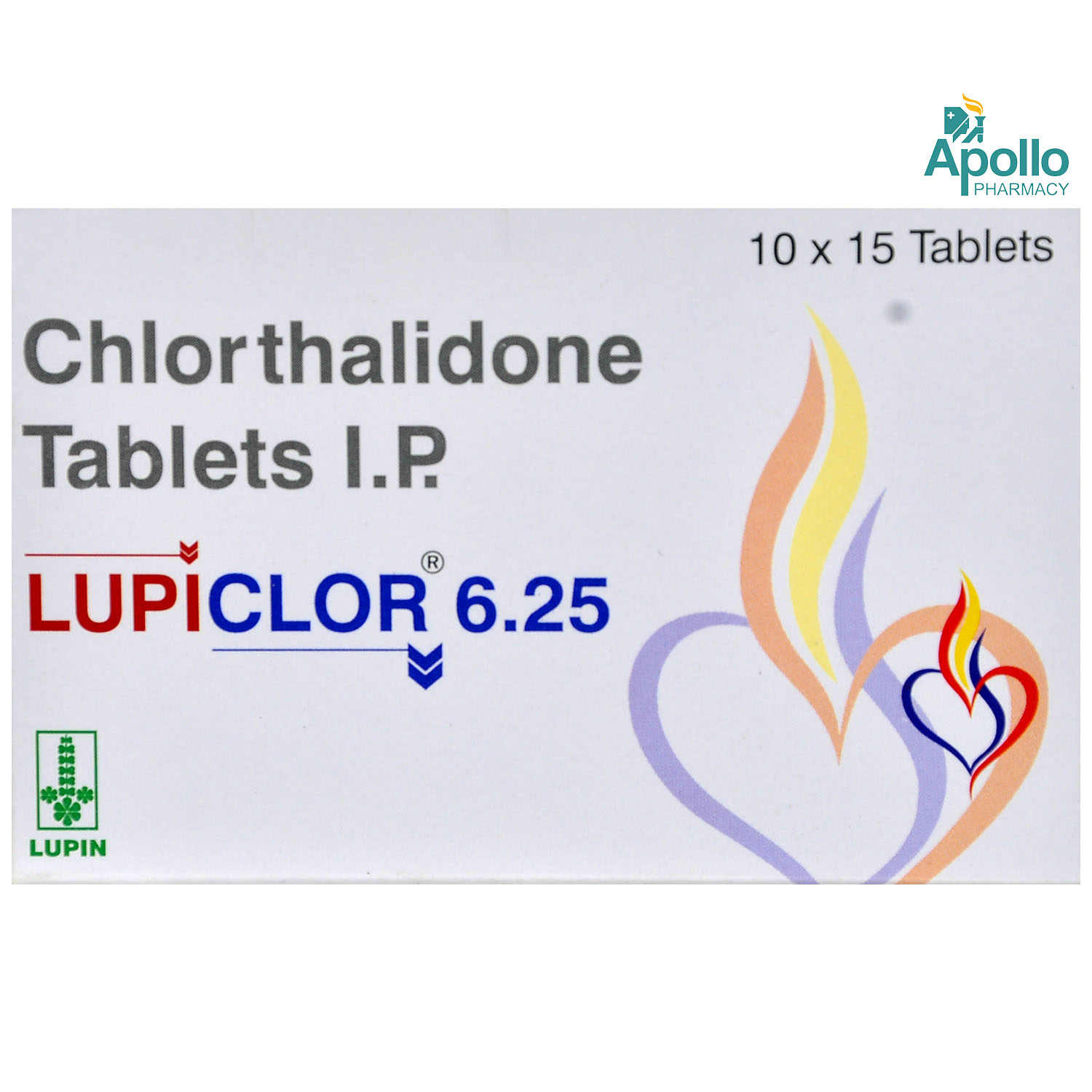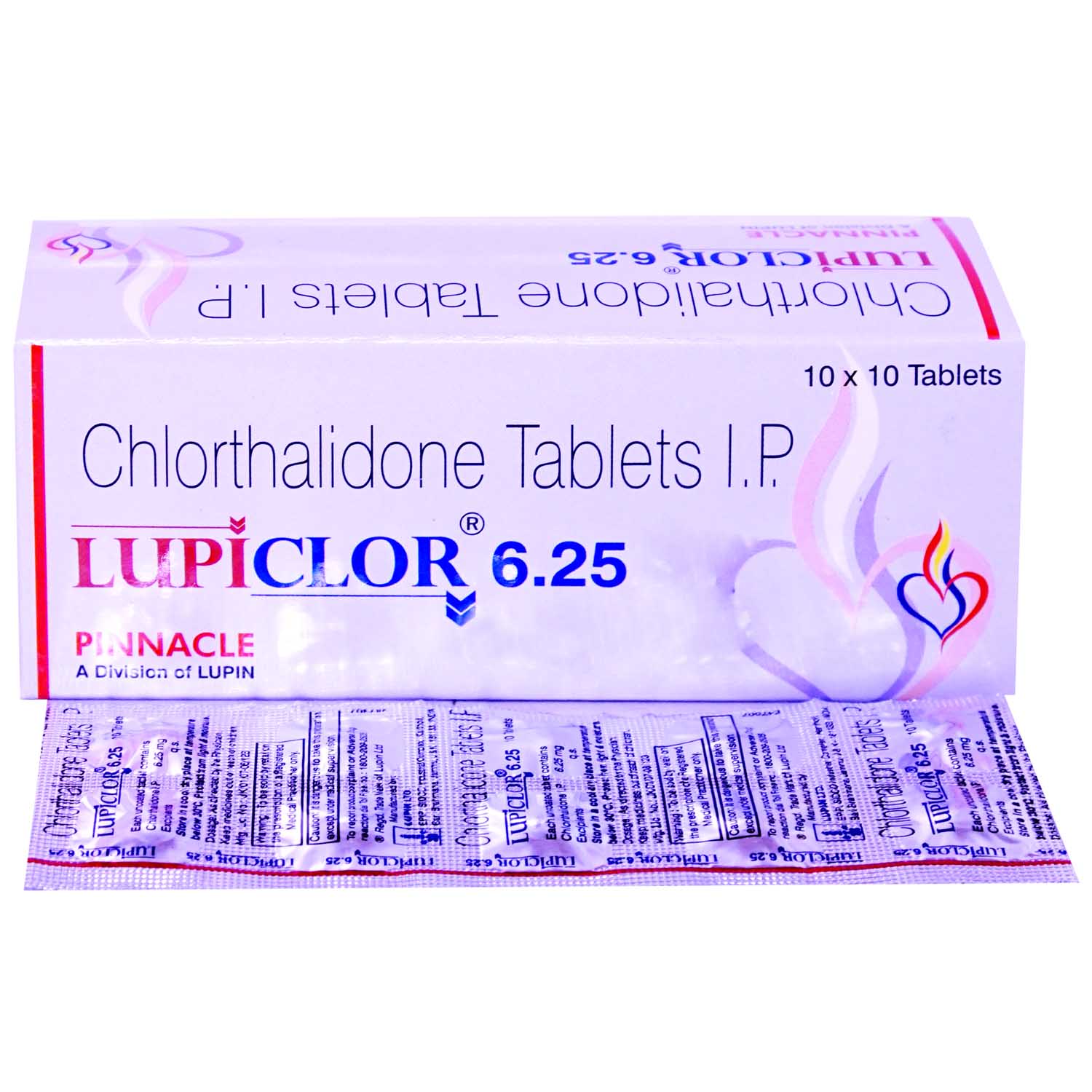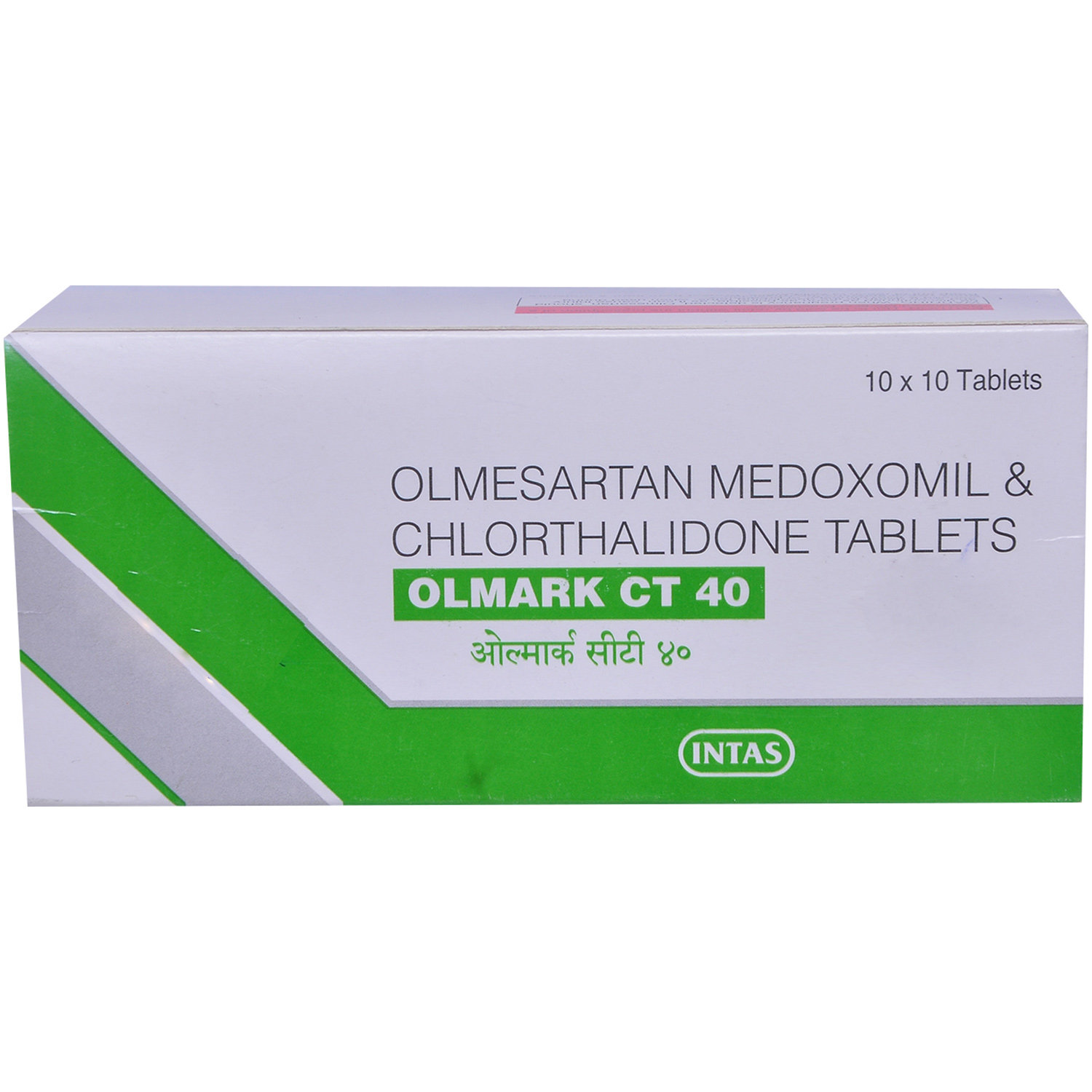CTD-6.25 Tablet 15's

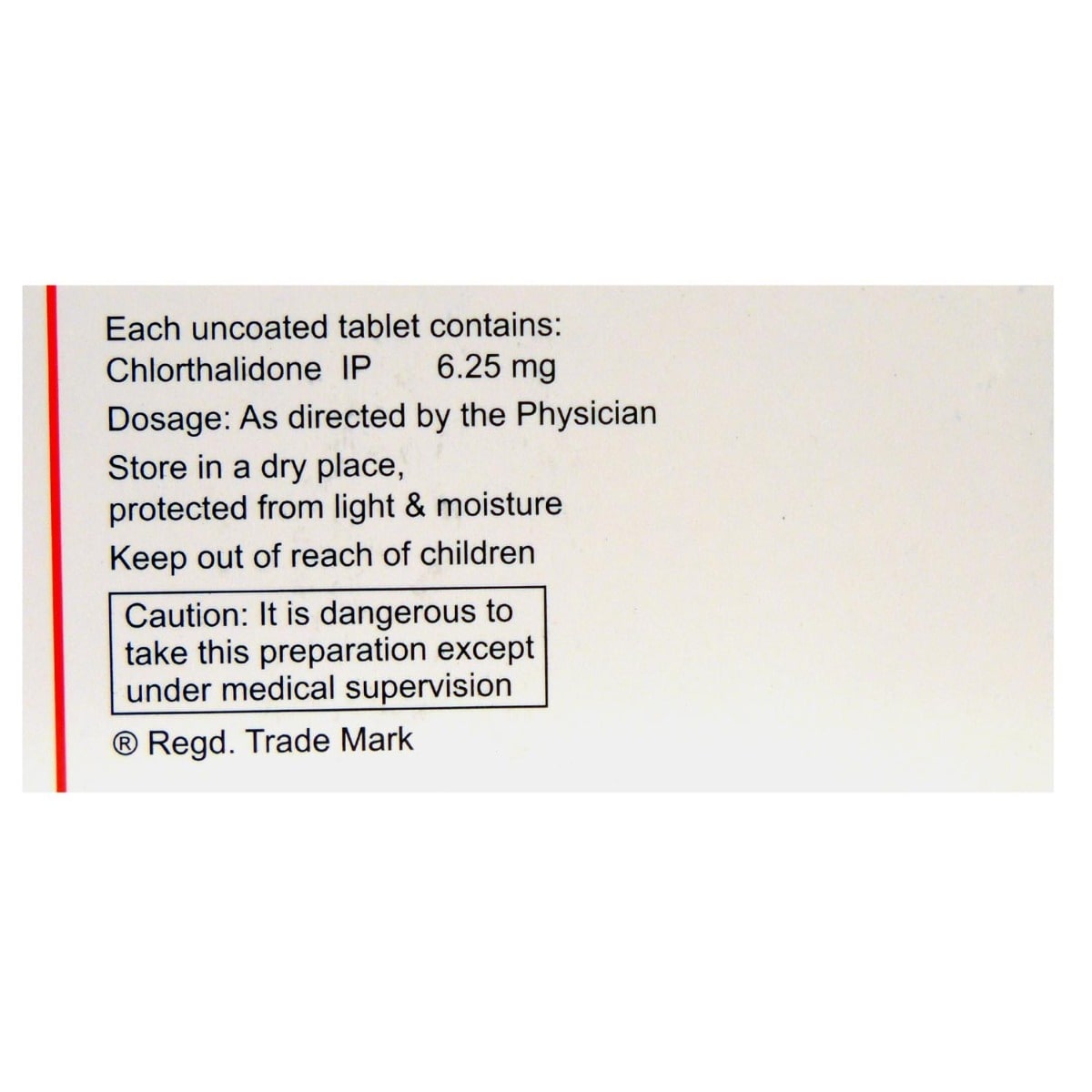
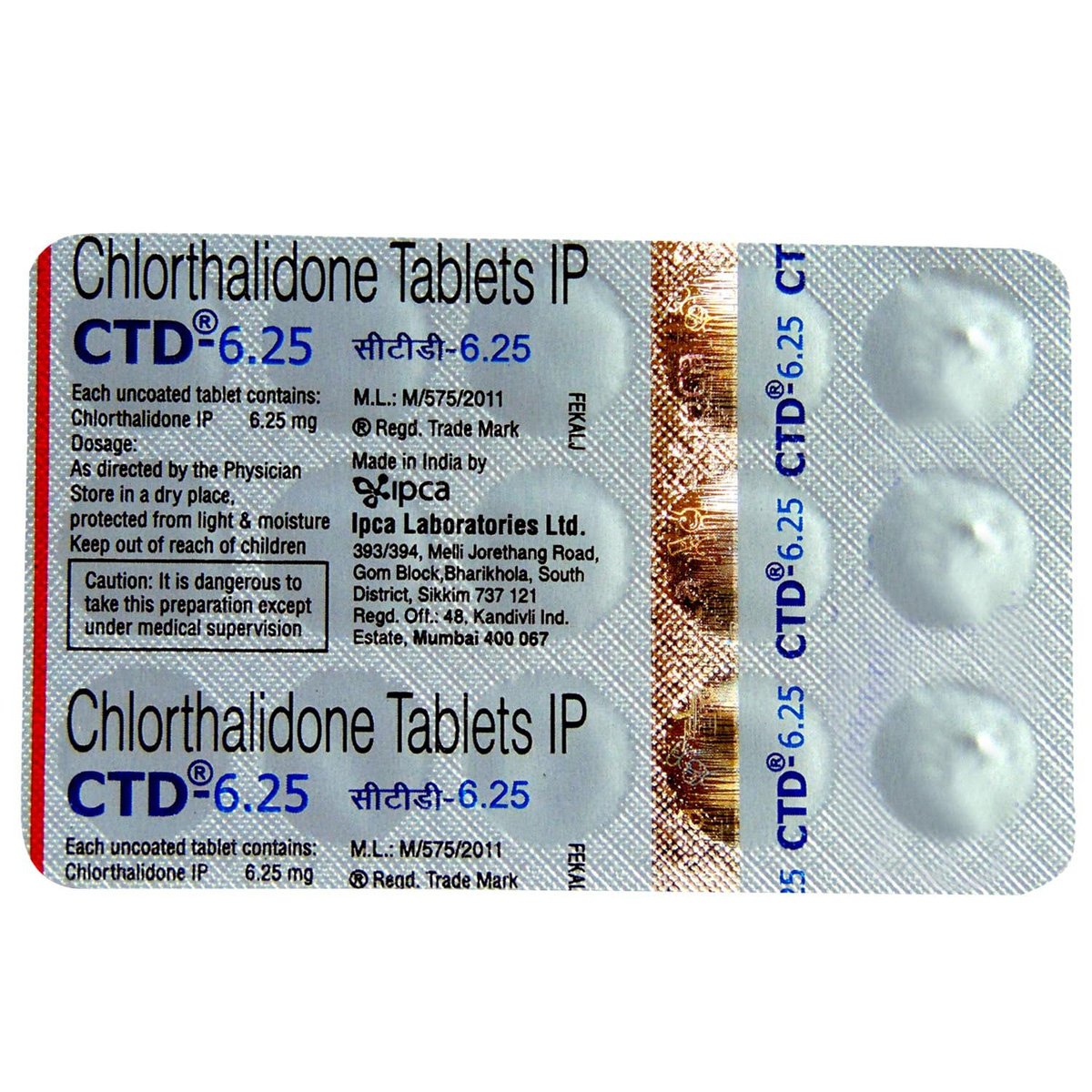



MRP ₹116.5
(Inclusive of all Taxes)
₹17.5 Cashback (15%)
Provide Delivery Location
Online payment accepted
 Prescription drug
Prescription drugWhats That
Composition :
Manufacturer/Marketer :
Consume Type :
Expires on or after :
Return Policy :
About CTD-6.25 Tablet
CTD-6.25 Tablet belongs to a group of medicines known as diuretics (water pills which increase urine production) primarily used to treat high blood pressure, heart failure, and oedema (a build-up of fluid in the body). Hypertension or high blood pressure is a lifelong or chronic condition in which the force exerted by the blood against the blood vessel (arteries wall) increases. The higher this blood pressure, the harder the heart has to pump. As a result, it leads to heart diseases, irregular heartbeat, and other complications. Oedema may occur in case of high blood pressure where fluids of the body get trapped in the tissues of the hands, arms, feet, ankles, and legs, leading to swelling.
CTD-6.25 Tablet contains Chlorthalidone, and it works by increasing the amount of urine passed out from the kidneys. It effectively reduces excess fluid levels in the body and treats oedema (swelling) associated with heart, liver, kidney, or lung disease. This, in turn, reduces the workload on the heart and makes the heart more efficient at pumping blood throughout the body. So, it helps to lower high blood pressure, reducing the chances of heart attack or stroke.
In some cases, you may experience headaches, nausea, or dizziness. Most of these side effects of CTD-6.25 Tablet do not require medical attention and gradually resolve over time. However, if the side effects are persistent, reach out to your doctor.
Try not to stop taking this medicine of your own. Tell your doctor about this, as it may cause a rise in blood pressure and can increase the risk of getting heart complications like stroke and heart diseases. Inform your doctor if you are suffering from kidney, liver, or heart disease or are diabetic. If you are pregnant or breastfeeding, please tell your doctor so that the dosage of CTD-6.25 Tablet can be prescribed accordingly. Taking CTD-6.25 Tablet during pregnancy may cause side effects like jaundice (yellowing of the skin or eyes), unexplained bleeding, low blood sugar, or an electrolyte imbalance in the newborn baby. Do not use CTD-6.25 Tablet if you are unable to urinate, have low blood pressure (hypotension), gout (excess uric acid), high cholesterol (hyperlipidaemia), cardiogenic shock (sudden stopping of blood flow to the heart). Please tell your doctor if you are taking any other medicines or are allergic to this medicine. Reducing the amount of table salt (sodium chloride) in your food often relieves the swelling of the body.
Uses of CTD-6.25 Tablet
Directions for Use
Key Benefits
When you take CTD-6.25 Tablet , the blood vessels in your body will be relaxed, which will help lower the raised blood pressure. Also, it widens the blood vessels (lining of arteries wall) and helps to improve the blood flow. It helps in losing out excess fluids from the body by increasing the production of urine. This reduces the workload on the heart and makes the heart more efficient at pumping blood throughout the body. Thus, it helps to lower high blood pressure, reducing the chances of heart attack or stroke. CTD-6.25 Tablet also helps decrease fluid buildup, which reduces inflammation or swelling. In addition, this relieves oedema and helps you carry out your daily activities more efficiently.
Storage
- Inform your doctor about the nausea and discuss possible alternatives to the medication or adjustments to the dosage.
- Divide your daily food intake into smaller, more frequent meals to reduce nausea.
- Opt for bland, easily digestible foods like crackers, toast, plain rice, bananas, and applesauce.
- Avoid certain foods that can trigger nausea, such as fatty, greasy, spicy, and smelly foods.
- Drink plenty of fluids, such as water, clear broth, or electrolyte-rich beverages like coconut water or sports drinks.
- Use ginger (tea, ale, or candies) to help relieve nausea.
- Get adequate rest and also avoid strenuous activities that can worsen nausea.
- Talk to your doctor about taking anti-nausea medication if your nausea is severe.
- Record when your nausea occurs, what triggers it, and what provides relief to help you identify patterns and manage your symptoms more effectively.
- Preventing Vomiting (Before it Happens)
- Take medication exactly as prescribed by your doctor. This can help minimize side effects, including vomiting.
- Having a small meal before taking your medication can help reduce nausea and vomiting.
- Talk to your doctor about taking anti-nausea medication along with your prescribed medication.
- Managing Vomiting (If it Happens)
- Try taking ginger in the form of tea, ale, or candy to help alleviate nausea and vomiting.
- What to Do if Vomiting Persists
- Consult your doctor if vomiting continues or worsens, consult the doctor for guidance on adjusting your medication or additional treatment.
- Drink plenty of fluids and stay hydrated.
- Avoid foods containing sugars, salts and processed food.
- Avoid consumption of alcohol.
- Take healthy diet containing fiber, carbohydrates and lean proteins.
- Exercise regularly and maintain a healthy lifestyle.
- Inform Your Doctor: Notify your doctor immediately about your diarrhoea symptoms. This allows them to adjust your medication or provide guidance on managing side effects.
- Stay Hydrated: Drink plenty of fluids to replace lost water and electrolytes. Choose water, clear broth, and electrolyte-rich drinks. Avoid carbonated or caffeinated beverages to effectively rehydrate your body.
- Follow a Bland Diet: Eat easy-to-digest foods to help firm up your stool and settle your stomach. Try incorporating bananas, rice, applesauce, toast, plain crackers, and boiled vegetables into your diet.
- Avoid Trigger Foods: Steer clear of foods that can worsen diarrhoea, such as spicy, fatty, or greasy foods, high-fibre foods, and dairy products (especially if you're lactose intolerant).
- Practice Good Hygiene: Maintain good hygiene to prevent the spread of infection. To stay healthy, wash your hands frequently, clean and disinfect surfaces regularly, and avoid exchanging personal belongings with others.
- Take Anti-Diarrheal Medications: If your doctor advises, anti-diarrheal medications such as loperamide might help manage diarrhoea symptoms. Always follow your doctor's directions.
- Keep track of your diarrhoea symptoms. If they don't get better or worse or are accompanied by severe stomach pain, blood, or dehydration signs (like extreme thirst or dark urine), seek medical help.
- Inform your doctor about your constipation symptoms. They may adjust your medication or advise alternative treatments.
- Stay hydrated by drinking sufficient of water (at least 8-10 glasses a day) to help soften stool and promote bowel movements.
- Increase fibre intake by eating foods high in fibre, such as fruits, whole grains, vegetables and legumes, to help bulk up the stool.
- Establish a bowel routine by trying to go to the bathroom at the same time each day to train your bowels.
- Engaging in regular exercise, like walking or yoga, can support in bowel movement stimulation.
- Consult your doctor if constipation persists, and discuss alternative treatments or adjustments to your medication.
Drug Warnings
CTD-6.25 Tablet should not be given to the people allergic to CTD-6.25 Tablet , have low blood pressure (less than 90 mm of Hg), have had a heart attack, kidney disease, liver disease, gout (high uric acid), high cholesterol (hyperlipidemia), pregnant women, or planning to get pregnant and breastfeeding women. Besides this, it is contraindicated in people with cardiogenic shock (sudden stopping of blood flow to the heart), and aortic stenosis (heart valve problem). CTD-6.25 Tablet can pass into breast milk, but its effect on the baby is unknown. So, it is better to tell your doctor if you are taking CTD-6.25 Tablet and breastfeeding. Tell your doctor if you are on low sodium (table salt) diet. Cases of electrolyte imbalance have been observed (like low levels of sodium, potassium, or magnesium in your blood). So your doctor might advise monitoring blood pressure, kidney function test, and electrolytes.
Drug-Drug Interactions
Drug-Drug Interactions
Login/Sign Up
Co-administration of CTD-6.25 Tablet and cisapride may increase the risk or severity of an irregular heart rhythm that may be serious.
How to manage the interaction:
Taking CTD-6.25 Tablet with Cisapride is not recommended, please consult your doctor before taking it. Do not discontinue the medication without consulting a doctor.
Co-administration of Aminolevulinic acid and CTD-6.25 Tablet may increase the risk of severe sunburn.
How to manage the interaction:
Taking CTD-6.25 Tablet with Aminolevulinic acid together can possibly result in an interaction, but it can be taken if a doctor has advised it. If you notice that your skin is very sensitive to sunlight or if you have a really bad sunburn, it's important to contact your doctor right away. Do not discontinue any medications without consulting a doctor.
Taking Droperidol can make CTD-6.25 Tablet less effective in lowering blood pressure.
How to manage the interaction:
Taking CTD-6.25 Tablet with Droperidol together can possibly result in an interaction, but it can be taken if your doctor has advised it. If you have any of these symptoms, it's important to contact your doctor right away. These symptoms include an irregular heart rhythm, severe or long-lasting diarrhea or vomiting, complications, sudden dizziness or lightheadedness, fainting, difficulty breathing, heart palpitations, weakness, feeling sleepy or confused, muscle pain, and feeling nauseous or vomiting. Do not stop using any medications without first talking to your doctor.
Co-administration of CTD-6.25 Tablet together with lithium can increase the effects of lithium.
How to manage the interaction:
Although there is a interaction between CTD-6.25 Tablet and lithium, but it can be taken together if prescribed by a doctor. However, consult your doctor if you experience diarrhea, vomiting, drowsiness, shaking of hands and legs, thirst, increased urination, lack of coordination, or muscle weakness. Do not discontinue any medications without consulting a doctor.
Co-administration of Tizanidine and CTD-6.25 Tablet may show additive effects and increase the risk of low blood pressure.
How to manage the interaction:
Although there is an interaction, CTD-6.25 Tablet can be taken with tizanidine if prescribed by the doctor. If you experience headache, dizziness, palpitations, or sweating, contact your doctor immediately. Do not discontinue any medications without consulting a doctor.
Co-administration of CTD-6.25 Tablet with ziprasidone can increase the risk of an irregular heart rhythm that may be serious.
How to manage the interaction:
Although there is an interaction, CTD-6.25 Tablet can be taken with ziprasidone if prescribed by the doctor. but it can be taken together if prescribed by a doctor. However, consult your doctor if you experience sudden dizziness, lightheadedness, fainting, shortness of breath, weakness, tiredness, drowsiness, confusion, muscle pain, cramps, nausea, or vomiting. Do not discontinue any medications without consulting a doctor.
Co-administration of CTD-6.25 Tablet with pimozide can increase the risk of an irregular heart rhythm that may be serious.
How to manage the interaction:
Although there is an interaction, CTD-6.25 Tablet can be taken with pimozide if prescribed by the doctor. Consult the prescriber if you develop sudden dizziness, lightheadedness, fainting, or fast or pounding heartbeats during treatment with pimozide. Also, let the doctor know if you experience signs of electrolyte disturbance, such as weakness, tiredness, drowsiness, confusion, muscle pain, cramps, dizziness, nausea, or vomiting. Do not discontinue any medications without consulting a doctor.
Coadministration of CTD-6.25 Tablet with amiodarone may increase the risk of abnormal heart rhythms.
How to manage the interaction:
Although taking CTD-6.25 Tablet with amiodarone may cause an interaction, it is safe to do so if your doctor has prescribed it. If you have a cardiac problem or electrolyte imbalances, you may be more vulnerable. If you develop sudden dizziness, lightheadedness, fainting, shortness of breath, or a rapid heartbeat, consult a doctor. Do not stop taking any medications without visiting a doctor.
Taking CTD-6.25 Tablet can make the body eliminate Arsenic trioxide faster, leading to lower levels in the blood and potentially reducing its effectiveness.
How to manage the interaction:
Co-administration of CTD-6.25 Tablet with Arsenic trioxide can possibly result in an interaction, but it can be taken if a doctor has advised it. If you have any of these symptoms, it's important to contact a doctor right away: your heart beating irregularly, feeling dizzy or lightheaded, fainting, having a fast or pounding heartbeat, feeling weak or drowsy, being confused, experiencing muscle pain, or feeling nauseous or vomiting. Do not discontinue any medications without consulting a doctor.
Drug-Food Interactions
Drug-Food Interactions
Login/Sign Up
Diet & Lifestyle Advise
- Consume antioxidant-rich food. Blueberries, cherries, tomatoes, squash, and bell peppers are high in antioxidants.
- Eat natural diuretic foods. Asparagus, beets, green beans, grapes, onion, leafy greens, pineapple, leeks, pumpkin, and garlic are all-natural diuretic foods.
- Use healthy cooking oils like soybean, olive, canola, and coconut oil.
- You should avoid refined foods such as white bread, spaghetti, sugar, and red meat.
- Reduce or eliminate Trans fatty acids, which are found in commercially baked items such as cookies, cakes, crackers, French fries, onion rings, doughnuts, and processed foods.
- Avoid consumption of too much salt or salty food.
- Keep your weight under control with a BMI of 19.5-24.9.
- Regular physical activity or exercise like walking improves your blood flow.
- When possible, elevate your legs or the swollen area on a chair or pillows.
- Avoid standing or sitting for extended periods of time.
- Avoid chronic stress as it can raise your blood pressure.
- Spend time with your loved ones to cope with stress and practice mindfulness techniques.
- Quitting smoking and alcohol consumption is the best strategy to lower the risk of many health complications.
Side Effects of CTD-6.25 Tablet
- Bradycardia (slow heart rate)
- Hyperglycemia
- Hyperuricemia (an excess of uric acid in the blood)
- Muscle spasm
- Nausea
- Extreme tiredness
Habit Forming
Therapeutic Class
All Substitutes & Brand Comparisons
RX
Out of StockCloridone 6.25mg Tablet 10's
Maxford Labs Pvt Ltd
₹34.2
(₹3.08 per unit)
55% CHEAPERRX
Out of StockClovet 6.25 mg Tablet 10's
Ajanta Pharma Ltd
₹35
(₹3.15 per unit)
54% CHEAPERRX
Out of StockThalidon 6.25mg Tablet
Johnlee Pharmaceuticals Pvt Ltd
₹40
(₹3.6 per unit)
48% CHEAPER
Product Substitutes
Author Details
We provide you with authentic, trustworthy and relevant information
Drug-Diseases Interactions
Drug-Diseases Interactions
Login/Sign Up
Thiazide diuretics should not be used in people who have anuria.
How to manage the interaction:
CTD-6.25 Tablet is contraindicated in patients with anuria.
Thiazide diuretics should not be used in people who have anuria.
How to manage the interaction:
CTD-6.25 Tablet is contraindicated in patients with anuria.
Thiazide diuretics are usually associated with electrolyte loss, most notably potassium, but also sodium, chloride, bicarbonate, and magnesium. Other electrolytes, such as phosphate, bromide, and iodide, are normally lost in trace amounts. Potassium and magnesium deficiency can cause arrhythmias and cardiac arrest. Metabolic alkalosis and hyponatremia are two other electrolyte-related disorders that are seldom fatal.
How to manage the interaction:
Therapy with CTD-6.25 Tablet should be administered cautiously in patients with or predisposed to fluid and electrolyte depletion. Fluid and electrolyte abnormalities should be corrected before initiating therapy, and blood pressure and serum electrolyte concentrations should be monitored periodically and maintained at normal ranges during therapy. Consult the doctor if you experience signs and symptoms of fluid or electrolyte imbalance, including dry mouth, thirst, weakness, lethargy, drowsiness, restlessness, muscle pains or cramps, muscular fatigue, hypotension, oliguria, tachycardia, arrhythmia, or gastrointestinal disturbances such as nausea and vomiting.
Thiazide-induced hypokalemic hypochloremic alkalosis is especially dangerous in patients with severe liver disease or cirrhosis. In individuals with already elevated amounts, blood ammonia levels may rise further. Electrolyte changes associated with diuretic usage have resulted in hepatic encephalopathy and mortality. Thiazide diuretic therapy should be used with caution in patients with poor hepatic function or progressive liver disease, and should be stopped immediately if indications of imminent hepatic coma occur (e.g., tremors, disorientation, and increasing jaundice).
How to manage the interaction:
Therapy with CTD-6.25 Tablet should be administered cautiously in patients with impaired liver function or progressive liver disease, and discontinued promptly if signs of impending hepatic coma appear.
Thiazide diuretics have been reported to worsen or activate systemic lupus erythematosus. Chlorothiazide and hydrochlorothiazide have been linked to reported instances. Thiazide diuretics should be used with caution in individuals having a history or risk of SLE.
How to manage the interaction:
The use of CTD-6.25 Tablet has been reported to possibly exacerbate or activate systemic lupus erythematosus (SLE). Therapy with thiazide diuretics should be administered cautiously in patients with a history or risk of SLE.
Thiazide diuretics may be ineffective when the glomerular filtration rate (GFR) is low (less than 25 mL/min) because they are not expected to be filtered into the renal tubule, where they work. Furthermore, thiazide diuretics lower GFR and may cause azotemia in patients with renal failure. Because most of these medicines are eliminated unaltered in the urine through glomerular filtration and active tubular secretion, cumulative effects may occur. Thiazide diuretic therapy should be used with caution and at lower doses in individuals with renal impairment. If renal function worsens over time, as shown by increased BUN or serum creatinine levels, thiazide medication should be interrupted or discontinued.
How to manage the interaction:
Therapy with CTD-6.25 Tablet should be administered cautiously at reduced dosages in patients with kidney impairment.
Thiazide diuretics should be administered with caution in individuals with a history of bronchial asthma because to the possibility of hypersensitive responses.
How to manage the interaction:
CTD-6.25 Tablet should be used with caution in patients with history of bronchial asthma as sensitivity reactions may occur.
Thiazide diuretics can induce hyperglycemia and glycosuria in diabetics. They can also cause diabetes in pre-diabetic persons. These symptoms are normally reversible if the medicines are stopped. Thiazide diuretic therapy should be used with caution in individuals with diabetes, glucose intolerance, or a propensity to hyperglycemia. Diabetes mellitus patients should be regularly watched during thiazide medication, and their antidiabetic regimen should be changed accordingly.
How to manage the interaction:
CTD-6.25 Tablet may cause high blood sugar levels and glycosuria (glucose in the urine) in patients with diabetes. Therapy with CTD-6.25 Tablet should be administered cautiously in patients with diabetes mellitus, glucose intolerance, or a predisposition to high blood sugar levels. Patients with diabetes mellitus should be monitored more closely during therapy.
Thiazide diuretics may raise blood triglyceride and cholesterol levels, particularly LDL and VLDL. It is uncertain if these effects are dose-related and persist throughout chronic treatment. Patients with pre-existing hyperlipidemia may require stricter monitoring during thiazide medication, and their lipid-lowering regimen may need to be adjusted accordingly.
How to manage the interaction:
CTD-6.25 Tablet may increase serum triglyceride and cholesterol levels, primarily low-density lipoprotein and very low-density lipoprotein. Patients with preexisting hyperlipidemia may require closer monitoring during thiazide therapy.
Thiazide diuretics reduce urinary calcium excretion when used on a long-term basis. Prolonged treatment has been associated with pathologic alterations in the parathyroid gland, including hypercalcemia and hypophosphatemia. However, typical hyperparathyroidism consequences such as renal lithiasis, bone resorption, and peptic ulcers have not been observed. Clinicians should be aware of these side effects while prescribing or providing thiazide medication to hyperparathyroid patients. These medications should be stopped before doing parathyroid function testing.
How to manage the interaction:
Caution is advised while using CTD-6.25 Tablet in patients with hyperparathyroidism.
Thiazide diuretics slow the excretion of uric acid. Except in patients with a history of gout or chronic renal failure, hyperuricemia is typically asymptomatic and seldom progresses to clinical gout. Thiazide diuretic therapy should be used with caution in such individuals.
How to manage the interaction:
CTD-6.25 Tablet may decrease the rate of uric acid excretion. Therapy should be administered cautiously in such patients.
Thiazide diuretics may lower serum PBI (protein-bound iodine) levels without causing thyroid problems. When prescribing or providing thiazide medication to patients with thyroid problems, clinicians should be aware of this consequence.
How to manage the interaction:
Thiazide diuretics may decrease serum PBI (protein-bound iodine) levels without associated thyroid disturbance. Inform the prescriber if you have thyroid disorders.
FAQs
CTD-6.25 Tablet contains Chlorthalidone, and it works by increasing the amount of urine passed out from the kidneys. It effectively reduces excess fluid levels in the body and treats oedema (swelling) associated with heart, liver, kidney, or lung disease. This, in turn, reduces the workload on the heart and makes the heart more efficient at pumping blood throughout the body. So, it helps to lower high blood pressure, reducing the chances of heart attack or stroke.
Yes, CTD-6.25 Tablet can cause dizziness. It is advised to avoid driving or operate any heavy machinery while taking CTD-6.25 Tablet . In case you feel dizzy or lightheaded, it is advised to rest for some time until you feel better.
Taking CTD-6.25 Tablet may cause dehydration. So, to avoid dehydration, drink plenty of fluids and inform your doctor if you feel extremely thirsty.
It's unlikely that CTD-6.25 Tablet affects fertility in men or women. However, some water pills like hydrochlorothiazide may lead to erectile dysfunction. There's not enough evidence to say for certain. For the best advice, consult your doctor.
CTD-6.25 Tablet can be safely taken as long as your doctor has prescribed it to you. Conditions such as high blood pressure are life-long conditions and one should not abruptly discontinue it without discussing it with a doctor.
No, you are advised to inform your doctor and monitor your blood pressure for at least two weeks before stopping the medicine. Depending upon your current blood pressure readings, there is a possibility your doctor may lower your medicine dosage and not recommend discontinuing it.
Drug-Drug Interactions Checker List
- METOPROLOL
- RAMIPRIL
- HYDROCHLOROTHIAZIDE
- ATORVASTATIN
- SILDENAFIL
- CARBAMAZEPINE
- PHENOBARBITAL
- IBUPROFEN
- ASPIRIN
Special Advise
If you have taken high doses drink more water and Consult your doctor immediately.
Disease/Condition Glossary
Hypertension: It is a chronic condition when blood pressure is too high. This condition can lead to hardened arteries (blood vessels), decreasing the blood and oxygen flow to the heart. Blood pressure is the measurement of the force our heart uses to pump blood to all body parts. Raised blood pressure can cause chest pain (angina) and heart attack (when blood supply to the heart is blocked). Additionally, high blood pressure also causes brain damage (stroke) and kidney failure. High blood pressure can be diagnosed with the help of a blood pressure monitor or sphygmomanometer. Systolic pressure is the pressure when the heart pumps blood out. On the other hand, diastolic pressure is the pressure when your heart is at the resting stage between heartbeats. If your blood pressure is 140/90 mm of Hg, it means the systolic pressure is 140 mm of Hg and diastolic pressure is 90 mm of Hg. Ideal blood pressure should be between 90/60 mm of Hg and 120/80 mm of Hg.
Oedema: Also known as 'dropsy' or 'hydropsy', is a condition of fluid retention in the body characterized by swelling of the body's tissue, including ankles, feet and legs. It is usually caused by standing or sitting in the same position for too long, eating too much salty food, and being overweight. Oedema mainly affects the lymphatic system (including the circulatory and immune system) and organs like the tonsils, spleen, and thymus that maintain fluid balance and fight infections.

Have a query?
Buy best Cardiology products by
Torrent Pharmaceuticals Ltd
Sun Pharmaceutical Industries Ltd
Lupin Ltd
Intas Pharmaceuticals Ltd
Cipla Ltd
Micro Labs Ltd
Macleods Pharmaceuticals Ltd
Abbott India Ltd
Ajanta Pharma Ltd
Ipca Laboratories Ltd
Eris Life Sciences Ltd
Mankind Pharma Pvt Ltd
Lloyd Healthcare Pvt Ltd
Dr Reddy's Laboratories Ltd
Glenmark Pharmaceuticals Ltd
Emcure Pharmaceuticals Ltd
Alembic Pharmaceuticals Ltd
Alkem Laboratories Ltd
East West Pharma India Pvt Ltd
USV Pvt Ltd
Zydus Healthcare Ltd
Aristo Pharmaceuticals Pvt Ltd
Elbrit Life Sciences Pvt Ltd
J B Chemicals & Pharmaceuticals Ltd
Zydus Cadila
Akumentis Healthcare Ltd
Alteus Biogenics Pvt Ltd
Hbc Life Sciences Pvt Ltd
Fusion Health Care Pvt Ltd
Troikaa Pharmaceuticals Ltd
La Renon Healthcare Pvt Ltd
Corona Remedies Pvt Ltd
Jubilant Lifesciences Ltd
Medley Pharmaceuticals Ltd
Knoll Healthcare Pvt Ltd
Msn Laboratories Pvt Ltd
Zuventus Healthcare Ltd
Cadila Pharmaceuticals Ltd
Blue Cross Laboratories Pvt Ltd
Lividus Pharmaceuticals Pvt Ltd
Morepen Laboratories Ltd
Ranmarc Labs
Shrrishti Health Care Products Pvt Ltd
Sanofi India Ltd
Steris Healthcare
Elder Pharmaceuticals Ltd
Primus Remedies Pvt Ltd
Unison Pharmaceuticals Pvt Ltd
Eswar Therapeutics Pvt Ltd
Knoll Pharmaceuticals Ltd
Tas Med India Pvt Ltd
Systopic Laboratories Pvt Ltd
Indiabulls Pharmaceuticals Pvt Ltd
Leeford Healthcare Ltd
Sinsan Pharmaceuticals Pvt Ltd
Biochem Pharmaceutical Industries Ltd
Cadila Healthcare Ltd
Azkka Pharmaceuticals Pvt Ltd
Nirvana India Pvt Ltd
Orsim Pharma
Prevego Healthcare & Research Pvt Ltd
Econ Healthcare
Elinor Pharmaceuticals (P) Ltd
FDC Ltd
Sunij Pharma Pvt Ltd
Nicholas Piramal India Ltd
Astra Zeneca Pharma India Ltd
Pfizer Ltd
Lia Life Sciences Pvt Ltd
Shine Pharmaceuticals Ltd
Elicad Pharmaceuticals Pvt Ltd
Indoco Remedies Ltd
Proqol Health Care Pvt Ltd
Vasu Organics Pvt Ltd
Biocon Ltd
Opsis Care Lifesciences Pvt Ltd
Johnlee Pharmaceuticals Pvt Ltd
Merck Ltd
Wockhardt Ltd
Auspharma Pvt Ltd
Ergos Life Sciences Pvt Ltd
Lakshya Life Sciences Pvt Ltd
Ordain Health Care Global Pvt Ltd
Pficus De Med Pvt Ltd
ALICAN PHARMACEUTICAL PVT LTD
RPG Life Sciences Ltd
Glynis Pharmaceuticals Pvt Ltd
Orris Pharmaceuticals
Samarth Life Sciences Pvt Ltd
Aprica Pharmaceuticals Pvt Ltd
Aretaeus Pharmaceuticals Pvt Ltd
Koye Pharmaceuticals Pvt Ltd
Neocardiab Care
Retra Life Science Pvt Ltd
Alniche Life Sciences Pvt Ltd
Alvio Pharmaceuticals Pvt Ltd
Arkas Pharma Pvt Ltd
Atos Lifesciences Pvt Ltd
Divine Savior Pvt Ltd
Metalis Lifesciences Pvt Ltd
Alcohol
Safe if prescribed
You are recommended not to consume alcohol along with CTD-6.25 Tablet to avoid unpleasant side-effects.
Pregnancy
Consult your doctor
CTD-6.25 Tablet is classified as FDA pregnancy risk category B. So, CTD-6.25 Tablet should not be used during pregnancy unless clearly necessary. Prolonged intake of CTD-6.25 Tablet during pregnancy may cause jaundice (yellowing of skin and eye), unexplained bruising, low blood sugar and electrolyte imbalance in the neonates (newborn baby). Your doctor will weigh the benefits and any potential risks before prescribing it to you. Please consult your doctor.
Breast Feeding
Consult your doctor
CTD-6.25 Tablet should not be used when breastfeeding unless clearly necessary. Your doctor will weigh the benefits and any potential risks before prescribing it to you. Please consult your doctor.
Driving
Safe if prescribed
Driving after taking CTD-6.25 Tablet is not recommended as it may occasionally cause drowsiness.
Liver
Consult your doctor
CTD-6.25 Tablet to be taken with caution, especially if you have a history of liver diseases/conditions. The dose may have to be adjusted by your doctor.
Kidney
Consult your doctor
CTD-6.25 Tablet to be taken with caution, especially if you have a history of kidney diseases/conditions. Your doctor may adjust your dose depending upon your current kidney conditions.
Children
Safe if prescribed
CTD-6.25 Tablet to be taken with caution, especially if you are children below the age of 12. Your doctor may adjust your dose depending upon your age.
Recommended for a 30-day course: 2 Strips




